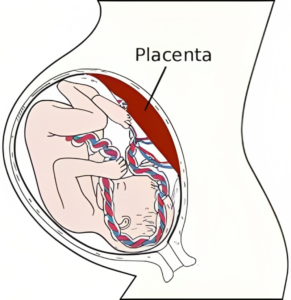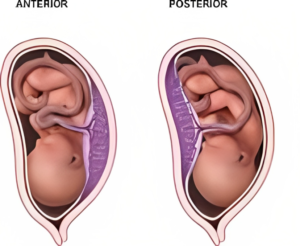Table of Contents
Posterior Placenta: What Does It Mean for You and Your Baby?
If you are pregnant, you may have heard the term posterior placenta from your doctor or ultrasound report. But what does it mean and how does it affect your pregnancy and delivery? In this blog post, we will explain everything you need to know about the posterior placenta, including its definition, benefits, risks, and implications.
What is a posterior placenta?
The placenta is a temporary organ that develops during pregnancy to provide oxygen and nutrients to your baby through the umbilical cord. It also removes waste products and hormones from your baby’s blood.

The placenta can attach itself to any part of the uterus (the womb), but most commonly it attaches to the back wall of the uterus, closest to your spine. This is called a posterior placenta.
A posterior placenta is one of the most common and normal positions for the placenta to be in. It does not usually cause any problems or complications for you or your baby.
Differences Between Anterior Vs Posterior Placenta

| Categories | Anterior Placenta | Posterior Placenta |
|---|---|---|
| Location | Attached to the front of the uterine wall | Attached to the back of the uterine wall |
| Fetal Movements | Movements may be felt later or muted | Movements are usually felt earlier and more pronounced |
| Maternal Sensation | Less likely to feel kicks and movements | More likely to feel kicks and movements |
| Ultrasound Imaging | May obscure the view of the fetus in certain angles | Provides a clear view of the fetus during ultrasound |
| Delivery | May increase the likelihood of a cesarean section | No significant impact on the mode of delivery |
| Complications | Associated with a slightly higher risk of placenta previa | No significant association with specific complications |
What are the benefits of the posterior placenta?
Having a posterior placenta has some advantages, such as:
- You may feel your baby’s movements earlier and stronger than if you had an anterior placenta (when the placenta attaches to the front wall of the uterus, closest to your belly). This is because there is less cushioning between your baby and your abdominal wall.
- You may have a lower risk of placenta previa (when the placenta covers or partially covers the cervix, the opening of the uterus) than if you had an anterior placenta. Placenta previa can cause bleeding during pregnancy and delivery and may require a cesarean section (C-section).
- You may have a higher chance of having a vaginal delivery than if you had an anterior placenta. This is because a posterior placenta may help your baby get into an optimal position for birth, with their head down and facing your back (also known as the occiput anterior position). This position can make labor easier and faster.
What are the risks of the posterior placenta?
Having a posterior placenta does not usually pose any significant risks or challenges for you or your baby. However, there are some rare situations where a posterior placenta may cause some issues, such as:
- You may have a higher risk of back labor (when you feel most of the pain and contractions in your lower back) than if you had an anterior placenta. This is because a posterior placenta may put more pressure on your spine and nerves during labor.
- You may have a higher risk of vasa previa (when fetal blood vessels cross or run near the cervix) than if you had an anterior placenta. Vasa previa can cause severe bleeding and fetal distress during labor and delivery and may require an emergency C-section.
- You may have a higher risk of placental abruption (when the placenta separates from the uterine wall before or during labor) than if you had an anterior placenta. Placental abruption can cause bleeding, pain, and fetal distress and may require an emergency C-section.
How is the posterior placenta diagnosed?
A posterior placenta can be diagnosed by an ultrasound scan, usually done between 18 and 20 weeks of pregnancy. The ultrasound technician will look at the location and shape of the placenta and measure its distance from the cervix.
If you have a posterior placenta, it will be noted in your ultrasound report. However, it is not something that you need to worry about or pay much attention to. It is just one of the many aspects of your pregnancy that your doctor will monitor and manage.
How is the posterior placenta treated?
A posterior placenta does not require any special treatment or intervention. It is a normal and healthy position for the placenta to be in. You can have a normal pregnancy and delivery with a posterior placenta.
However, if you have any complications or concerns related to your posterior placenta, such as bleeding, pain, or reduced fetal movements, you should contact your doctor immediately. They will assess your condition and advise you on the best course of action.
Conclusion
A posterior placenta is when the placenta attaches itself to the back wall of the uterus, closest to your spine. It is one of the most common and normal positions for the placenta to be in. It does not usually cause any problems or complications for you or your baby.
Having a posterior placenta has some benefits, such as feeling your baby’s movements earlier and stronger, having a lower risk of placenta previa, and having a higher chance of having a vaginal delivery.
However, having a posterior placenta may also have some risks, such as a higher risk of back labor, vasa previa, and placental abruption. These are rare situations that can be managed by your doctor if they occur.
A posterior placenta can be diagnosed by an ultrasound scan, usually done between 18 and 20 weeks of pregnancy. It does not require any special treatment or intervention. You can have a normal pregnancy and delivery with a posterior placenta.
References
(1) Posterior Placenta: 5 Myths (and Facts) You Need to Know.
(2) Posterior Placenta Location: Is Posterior Positioning Good for the Baby?.
(3) Posterior Placenta 101: Meaning, Complications, Delivery – Be Bodywise.
FAQs
Q: What is a posterior placenta?
A: A posterior placenta refers to the placement of the placenta on the back wall of the uterus, closest to the mother’s spine.
Q: What are the characteristics of a posterior placenta?
A: A posterior placenta allows for an easier feeling of fetal movements, as they are often more pronounced and can be felt earlier in the pregnancy. It also provides a clear view of the fetus during ultrasound examinations.
Q: Does a posterior placenta affect the mode of delivery?
A: In general, a posterior placenta does not have a significant impact on the mode of delivery. The decision on the mode of delivery depends on other factors such as the mother’s health, fetal position, and any other complications that may be present.
Q: Can a posterior placenta lead to any complications?
A: A posterior placenta is not typically associated with specific complications. However, every pregnancy is unique, and individual circumstances may vary. It is important to consult with your healthcare provider for personalized information and to address any concerns.
Q: What are the advantages of a posterior placenta?
A: One advantage of a posterior placenta is that the movements of the fetus are usually felt earlier and more prominently, providing a sense of reassurance for the mother. Additionally, during ultrasound examinations, a posterior placenta allows for a clear view of the fetus, which can aid in monitoring its development.
Q: Can a posterior placenta cause any difficulties during pregnancy?
A: In most cases, a posterior placenta does not cause any difficulties during pregnancy. However, if the placenta is low-lying and covers the cervix (placenta previa), it can lead to complications and require careful monitoring by healthcare professionals.
Q: Is a posterior placenta common?
A: Yes, a posterior placenta is one of the most common placements of the placenta. However, the position of the placenta can vary from one pregnancy to another and between individuals.
Q: Can a posterior placenta affect the bonding between the mother and the baby?
A: The position of the placenta, including a posterior placement, does not impact the bonding between the mother and baby. Bonding is a complex emotional process that develops through interaction, care, and love between the mother and her child, regardless of the placenta’s position.